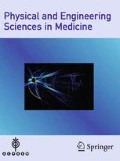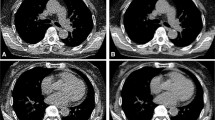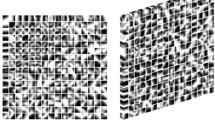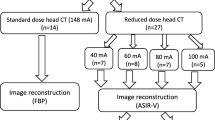Abstract
In CT, ionizing radiation exposure from the scan has attracted much concern from patients and doctors. This work is aimed at improving head CT images from low-dose scans by using a fast Dictionary learning (DL) based post-processing. Both Low-dose CT (LDCT) and Standard-dose CT (SDCT) nonenhanced head images were acquired in head examination from a multi-detector row Siemens Somatom Sensation 16 CT scanner. One hundred patients were involved in the experiments. Two groups of LDCT images were acquired with 50 % (LDCT50 %) and 25 % (LDCT25 %) tube current setting in SDCT. To give quantitative evaluation, Signal to noise ratio (SNR) and Contrast to noise ratio (CNR) were computed from the Hounsfield unit (HU) measurements of GM, WM and CSF tissues. A blinded qualitative analysis was also performed to assess the processed LDCT datasets. Fifty and seventy five percent dose reductions are obtained for the two LDCT groups (LDCT50 %, 1.15 ± 0.1 mSv; LDCT25 %, 0.58 ± 0.1 mSv; SDCT, 2.32 ± 0.1 mSv; P < 0.001). Significant SNR increase over the original LDCT images is observed in the processed LDCT images for all the GM, WM and CSF tissues. Significant GM–WM CNR enhancement is noted in the DL processed LDCT images. Higher SNR and CNR than the reference SDCT images can even be achieved in the processed LDCT50 % and LDCT25 % images. Blinded qualitative review validates the perceptual improvements brought by the proposed approach. Compared to the original LDCT images, the application of DL processing in head CT is associated with a significant improvement of image quality.





Similar content being viewed by others
Abbreviations
- LDCT:
-
Low-dose CT
- SDCT:
-
Standard-dose CT
- DL:
-
Dictionary learning
- K-SVD:
-
K-means singular value decomposition
- SD:
-
Standard deviation
- SNR:
-
Signal to noise ratio
- CNR:
-
Contrast to noise ratio
- CTDIvol :
-
Volume CT dose index
- DLP:
-
Dose length product
- ED:
-
Effective dose
- FBP:
-
Filtered back-projection
- mA:
-
Milliampere
- mAs:
-
Milliampere second
- HU:
-
Hounsfield unit
- ASIR:
-
Adaptive statistical iterative reconstruction
- PICCS:
-
Prior image constrained compressed sensing
- ROI:
-
Region of interest
References
Patient safety: Radiation dose in X-ray and CT Exams. http://www.radiologyinfo.org/en/safety/index.cfm?pg=sfty_xray. Accessed August 22, 2012
Kak AC, Slaney M (2001) Principles of Computerized Tomographic Imaging. SIAM, Philadelphia
Brenner DJ, Hall EJ (2007) Computed tomography-an increasing source of radiation exposure. N Engl J Med 357:2277–2284
Smith-Bindman R, Lipson J, Marcus R et al (2009) Radiation dose associated with common computed tomography examinations and the associated lifetime attributable risk of cancer. Arch Intern Med 169:2078–2086
Kalra MK, Michael MM et al (2004) Strategies for CT radiation dose optimization. Radiology 230:619–628
Yazdi M, Beaulieu L (2008) Artifacts in spiral x-ray CT scanners: problems and solutions. Int J Biol Med Sci 4:135–139
Xu J, Mahesh M, Tsui BM (2009) Is iterative reconstruction ready for MDCT? J Am Coll Radiol 6:274–276
Thibault JB, Sauer K, Bouman C et al (2007) A three-dimensional statistical approach to improved image quality for multislice helical CT. Med Phys 34:4526–4544
Sidky E, Pan X (2008) Image reconstruction in circular cone-beam computed tomography by constrained, total-variation minimization. Phys Med Biol 53:4777–4807
Chen Y, Feng Q, Luo L et al (2008) Nonlocal prior bayesian tomographic reconstruction. J Math Imaging Vis 30:133–146
Chen Y, Luo L, Chen W et al (2009) Bayesian statistical reconstruction for low-dose x-ray computed tomography using an adaptive-weighting nonlocal prior. Comput Med Imaging Graph 33:495–500
Lubner M, Pickhardt P, Tang J et al (2011) Reduced image noise at low-dose multidetector CT of the abdomen with prior image constrained compressed sensing algorithm. Radiology 260:248–256
Silva A, Lawder H, Hara A et al (2010) Innovations in CT dose reduction strategy: application of the adaptive statistical iterative reconstruction algorithm. Am J Roentgenol 194:191–199
Rapalino O, Kamalian S et al (2012) Cranial CT with adaptive statistical iterative reconstruction: improved image quality with concomitant radiation dose reduction. Am J Neuroradiol 33:609–615
Kilic K, Erbas G, Guryildirim M et al (2011) Lowering the dose in head CT using adaptive statistical iterative reconstruction. Am J Neuroradiol 32:1578–1582
Korn A, Fenchel M, Bender B et al (2012) Iterative reconstruction in head CT: image quality of routine and low-dose protocols in comparison with standard filtered back-projection. Am J Neuroradiol 33:218–224
Wu TH, Hung SC, Sun JY et al (2013) How far can the radiation dose be lowered in head CT with iterative reconstruction? analysis of imaging quality and diagnostic accuracy. Eur Radiol. doi:10.1007/s00330-013-2846-6
Leipsic J, Nguyen G, Brown J et al (2010) A prospective evaluation of dose reduction and image quality in chest CT using adaptive statistical iterative reconstruction. AJR Am J Roentgenol 195:1095–1099
Singh S, Kalra M, Hsieh J et al (2010) Abdominal CT, comparison of adaptive statistical iterative and filtered back projection reconstruction techniques. Radiology 257:373–383
Lewic MS, Olshausen BA, Field DJ (1996) Emergence of simple-cell receptive field properties by learning a sparse code for natural images. Nature 381:607–609
Lewicki MS, Sejnowski TJ (2000) Learning overcomplete representations. Neural Comput 12:337–365
Delgado KK, Murray JF et al (2003) Dictionary learning algorithms for sparse representation. Neural Comput 15:349–396
Donoho DL, Elad D (2003) Maximal sparsity representation via l1 minimization. Proc Natl Acad Sci 100:2197–2202
Elad M, Aharon M (2006) Image denoising via sparse and redundant representations over learned dictionaries. IEEE Trans Image Process 15:3736–3745
Mairal J, Elad M, Sapiro G (2007) Sparse representation for color image restoration. IEEE Trans Image Process 17:53–69
Mairal J, Sapiro G, Elad M (2008) Learning multiscale sparse representations for image and video restoration. SIAM Multiscale Model Sim 7:214–241
Wright J, Yang AY, Ganesh A et al (2008) Robust face recognition via sparse representation. IEEE Trans Pattern Anal Mach Intell 31:210–227
Ravishankar S, Bresler Y (2011) MR image reconstruction from highly under sampled k-space data by dictionary learning. IEEE Trans Med Imaging 30:1028–1041
Ma L, Moisan L, Yu J et al (2013) A Dictionary learning approach for Poisson image deblurring. IEEE Trans Med Imaging 32:1277–1289
Yu H, Wang G (2009) Compressed sensing based interior tomography. Phys Med Biol 54:2791–2805
Xu Q, Yu H, Mou X et al (2012) Low-Dose X-ray CT Reconstruction via Dictionary Learning. IEEE Trans Med Imaging 31:1682–1697
Li S, Fang L, Yin H (2012) An efficient dictionary learning algorithm and its application to 3-D medical image denoising. IEEE Trans Biomed Eng 59:417–427
Lu Y, Zhao J, Wang G (2012) Few-view image reconstruction with dual dictionaries. Phys Med Biol 57:173–189
Zhao B, Ding H, Lu Y, Wang G et al (2012) Dual-dictionary learning-based iterative image reconstruction for spectral computed tomography application. Phys Med Biol 57:8217–8229
Chen Y, Yin X, Shi L et al (2013) Improving abdomen tumor low-dose CT images using a fast dictionary learning based processing. Phys Med Biol 58:5803–5820
Heaney DE, Norvill CAJ (2006) A comparison of reduction in CT dose through the use of gantry angulations or bismuth shields. Australas Phys Eng SciMed 29(2):172–178
Jessen KA, Panzer W, Shrimpton PC, et al.(2000) EUR 16262: European Guidelines on Quality Criteria for Computed Tomography. Paper presented at: Office for Official Publications of the European Communities; Luxembourg
Shrimpton PC, Hillier MC, Lewis MA et al (2006) National survey of doses from CT in the UK: 2003. Br J Radiol 79(948):968–980
Hakansson M, Svensson S, Zachrisson S, et al. ViewDEX 2.0: a Java-based DICOM-compatible software for observer performance studies. Proc SPIE 2009; 7263: 72631G1-72631G10
Chen Y, Yang Z, Hu Y et al (2012) Thoracic low-dose CT image processing using an artifact-suppressed large-scale nonlocal means. Phys Med Biol 57:2667–2688
Feng Q, Foskey M, Chen W et al (2010) Segmenting CT prostate images using population and patient-specific statistics for radiotherapy. Med Phys 37:4121–4132
Yang J, Wang YT, Chen WF et al (2007) Multiresolution elastic registration of x-ray angiography images using thin-plate spline. IEEE Trans Nucl Sci 54:152–166
Acknowledgments
This research was supported by National Basic Research Program of China (2010CB732503), National Natural Science Foundation (81370040, 31100713), and the Natural Science Foundation of Jiangsu Province (BK2011593), This work was also supported by the Key Laboratory of Computer Network and Information Integration (Southeast University), Ministry of Education.
Author information
Authors and Affiliations
Corresponding author
Rights and permissions
About this article
Cite this article
Chen, Y., Shi, L., Yang, J. et al. Radiation dose reduction with dictionary learning based processing for head CT. Australas Phys Eng Sci Med 37, 483–493 (2014). https://doi.org/10.1007/s13246-014-0276-7
Received:
Accepted:
Published:
Issue Date:
DOI: https://doi.org/10.1007/s13246-014-0276-7




